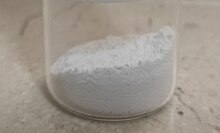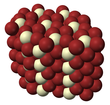 | |||
| |||
| Names | |||
|---|---|---|---|
| Other names Lanthanum trichloride | |||
| Identifiers | |||
| CAS Number |
| ||
| 3D model (JSmol) | |||
| ChEBI | |||
| ChemSpider | |||
| ECHA InfoCard | 100.030.202 | ||
| EC Number |
| ||
| PubChem CID | |||
| UNII |
| ||
| CompTox Dashboard (EPA) | |||
InChI
| |||
SMILES
| |||
| Properties | |||
| Chemical formula | LaCl3 | ||
| Molar mass | 245.264 g/mol (anhydrous) 353.36 g/mol (hexahydrate) 371.37 g/mol (heptahydrate) | ||
| Appearance | white odorless powder hygroscopic | ||
| Density | 3.84 g/cm | ||
| Melting point | 858 °C (1,576 °F; 1,131 K) (anhydrous) | ||
| Boiling point | 1,000 °C (1,830 °F; 1,270 K) (anhydrous) | ||
| Solubility in water | 957 g/L (25 °C) | ||
| Solubility | soluble in ethanol (heptahydrate) | ||
| Structure | |||
| Crystal structure | hexagonal (UCl3 type), hP8 | ||
| Space group | P63/m, No. 176 | ||
| Lattice constant | a = 0.74779 nm, b = 0.74779 nm, c = 0.43745 nm | ||
| Formula units (Z) | 2 | ||
| Coordination geometry | Tricapped trigonal prismatic,(nine-coordinate) | ||
| Related compounds | |||
| Other anions | Lanthanum oxide | ||
| Other cations | Cerium(III) chloride | ||
| Except where otherwise noted, data are given for materials in their standard state (at 25 °C , 100 kPa).
| |||
Lanthanum chloride is the inorganic compound with the formula LaCl3. It is a common salt of lanthanum which is mainly used in research. It is a white solid that is highly soluble in water and alcohols.
Preparation
Anhydrous lanthanum(III) chloride can be produced by the ammonium chloride route. In the first step, lanthanum oxide is heated with ammonium chloride to produce the ammonium salt of the pentachloride:
- La2O3 + 10 NH4Cl → 2 (NH4)2LaCl5 + 6 H2O + 6 NH3
In the second step, the ammonium chloride salt is converted to the trichlorides by heating in a vacuum at 350-400 °C:
- (NH4)2LaCl5 → LaCl3 + 2 HCl + 2 NH3
Uses
Lanthanum chloride is also used in biochemical research to block the activity of divalent cation channels, mainly calcium channels. Doped with cerium, it is used as a scintillator material.
In organic synthesis, lanthanum trichloride functions as a mild Lewis acid for converting aldehydes to acetals.
The compound has been identified as a catalyst for the high pressure oxidative chlorination of methane to chloromethane with hydrochloric acid and oxygen. In Fluid Catalytic Cracking (FCC), lanthanum chloride enhances catalysts to convert heavy crude into valuable fuels like gasoline and diesel.
Also used in the field of geology as a very dilute solution, which when combined with the proper acids can help identify small >1% Strontium content in powdered rock samples.
Lanthanum chloride also contributes to environmental remediation by promoting- the catalytic transformation of pollutants, such as nitrogen oxides (NOx), volatile organic compounds (VOCs), sulfur dioxide (SO₂), and phosphate ions, into less harmful products. It can also be commercially viable and significantly outperform conventional materials such as ion exchange resins, activated carbons, and iron oxides in water and wastewater treatment, especially for the removal of anionic pollutants.
References
- ^ Haynes, William M., ed. (2011). CRC Handbook of Chemistry and Physics (92nd ed.). CRC Press. p. 4.69. ISBN 978-1439855119.
- Morosin, B (1968). "Crystal Structures of Anhydrous Rare-Earth Chlorides". The Journal of Chemical Physics. 49 (7): 3007–3012. Bibcode:1968JChPh..49.3007M. doi:10.1063/1.1670543.
- Brauer, G., ed. (1963). Handbook of Preparative Inorganic Chemistry (2nd ed.). New York: Academic Press.
- Meyer, G. (1989). "The Ammonium Chloride Route to Anhydrous Rare Earth Chlorides—The Example of Ycl 3". The Ammonium Chloride Route to Anhydrous Rare Earth Chlorides-The Example of YCl3. Inorganic Syntheses. Vol. 25. pp. 146–150. doi:10.1002/9780470132562.ch35. ISBN 978-0-470-13256-2.
- Edelmann, F. T.; Poremba, P. (1997). Herrmann, W. A. (ed.). Synthetic Methods of Organometallic and Inorganic Chemistry. Vol. VI. Stuttgart: Georg Thieme Verlag. ISBN 978-3-13-103021-4.
- Martin, T; Allier, C; Bernard, F (2007). "Lanthanum Chloride Scintillator for X-ray Detection". AIP Conference Proceedings. Vol. 879. pp. 1156–1159. doi:10.1063/1.2436269.
- Lenin, R.; Raju, R. Madhusudhan (2007). "Lanthanum trichloride: An efficient Lewis acid catalyst for chemo and regioselective enamination of β-dicarbonyl compounds". Arkivoc. 2007 (13): 204–209. doi:10.3998/ark.5550190.0008.d23.
- Podkolzin SG, Stangland EE, Jones ME, Peringer E, Lercher JA (2007). "Methyl chloride production from methane over lanthanum-based catalysts". J. Am. Chem. Soc. 129 (9): 2569–76. doi:10.1021/ja066913w. PMID 17295483.
- Zhang, Zhongdong; Liu, Zhaoyong (2014). "The development of FCC catalysts for producing FCC gasoline with high octane numbers". Applied Petrochemical Research. 4: 379–383. doi:10.1007/s13203-014-0075-9.
- Loewen, Eric. "Lanthanum Chloride in Catalysis: Mechanisms and Applications". Stanford Advanced Materials. Retrieved Nov 6, 2024.
- Koh, Koh; Yang, Yi (2021). "Critical review on lanthanum-based materials used for water purification through adsorption of inorganic contaminants". Critical Reviews in Environmental Science and Technology. 52 (10): 1773–1823. doi:10.1080/10643389.2020.1864958.
| Lanthanum compounds | |
|---|---|
| Lanthanide salts of halides | |||||||||||||||||||||||||||||||||||||||||||||||||||||||||||||||||
|---|---|---|---|---|---|---|---|---|---|---|---|---|---|---|---|---|---|---|---|---|---|---|---|---|---|---|---|---|---|---|---|---|---|---|---|---|---|---|---|---|---|---|---|---|---|---|---|---|---|---|---|---|---|---|---|---|---|---|---|---|---|---|---|---|---|
| |||||||||||||||||||||||||||||||||||||||||||||||||||||||||||||||||

